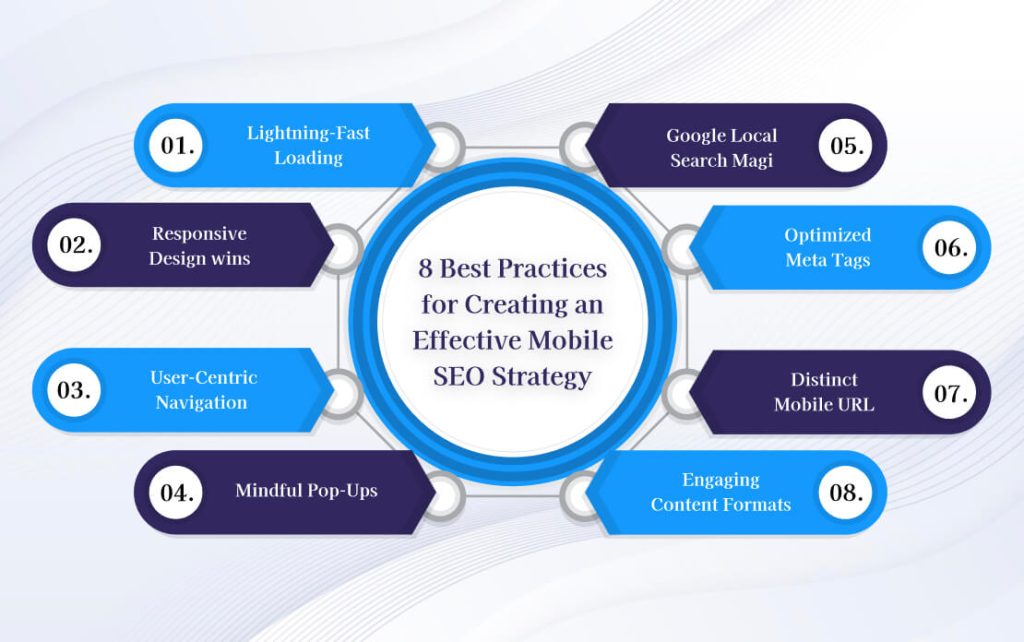Mobile SEO is about making your website perform better on smartphones and tablets. It helps your site rank higher in search results on mobile devices. With more people using mobiles for search, focusing on the mobile experience is vital. It involves practices similar to desktop SEO but is crucial for overall SEO success.
Optimizing site design, content, and other elements specifically for mobile devices is essential. Even the keywords you choose may vary when optimizing for mobile SEO. It ensures your website provides a great experience and ranks well when people search using mobile devices.
What is Mobile SEO?
Mobile SEO, or Mobile Search Engine Optimization, is optimizing a website to ensure it performs well and delivers a positive user experience on mobile devices. The goal is to make the site easily accessible and visually appealing on smartphones and tablets.
With the widespread use of mobile devices, mobile SEO has become crucial for businesses. It involves various strategies to enhance the mobile-friendliness of a website, such as responsive design, fast loading times, and optimized content. Mobile SEO aims to cater to the growing number of users who access websites through their mobile devices, ensuring they have a seamless and enjoyable interaction with the site.
To prevent such setbacks, prioritize optimizing your site for mobile-friendliness. Stay tuned for additional tips on achieving effective mobile optimization.
Why is Mobile SEO Important?
Mobile SEO is vital due to the rising number of users using mobile devices to connect to the internet. The reasons why this is important:
1. Growing Mobile Usage: People browse and shop using mobile devices more than ever. You’ll miss an essential market part by not focusing on mobile SEO.
2. Positive User Experience: Mobile SEO ensures your website is well-designed and works on tablets and smartphones. The positive experience will encourage users to stay on your website and interact with your content.
3. Search Engine Rankings: Search engines, including Google, can prioritize mobile-friendly websites within their ranking. Focusing on mobile optimization increases your chance of being more prominent in search results. This makes it easier for people to find your website.
4. Credibility of Business A mobile-friendly site reflects positively on your company. People may be dissuaded from visiting a website that isn’t optimized for their mobile device, which could impact the perception of their brand.
5. Lower Bounce Rates: Sites designed for mobiles offer a lower bounce rate. If users discover a site easily accessible for navigation and viewing via their mobile devices, they tend to explore the area and stay longer.
6. Competitive Advantage: Many companies are investing in mobile-based SEO. To remain ahead of the pack, you need to be in line with industry standards and meet mobile user demands.
8 Best Practices for Creating an Effective Mobile SEO Strategy

In the ever-changing world of online marketing, implementing an efficient Mobile SEO plan is essential to reach and engage your customers. As the use of mobile devices continues to grow, making sure your site looks stunning and runs smoothly for mobile users is a must. Here are some of the most user-friendly best practices to assist you in creating an effective Mobile SEO plan.
1. Lightning-Fast Loading:
Speed is the key to user satisfaction. Mobile users demand immediate and immediate access to their information. Slow-loading websites could cause frustration and a higher bounce rate. Utilize Google PageSpeed Insights, which analyzes the speed at which your website loads. Implement the suggested improvements to ensure your website loads fast on mobile devices.
2. Responsive Design wins:
Responsive Design forms the foundation of a user-friendly experience on mobile devices. It lets your website adjust quickly to different screen sizes, ensuring users a seamless and enjoyable browsing experience. Users shouldn’t be forced to move their eyes when browsing your website. Consider a responsive design that can adapt to the different landscapes of smartphones.
3. User-Centric Navigation:
It is essential to have simple mobile navigation. Develop a simple menu structure that lets users navigate efficiently. Consider using a hamburger menu to create an easy navigation experience. The idea is to search for the information you need on your mobile website for an effortless and enjoyable experience.
4. Mindful Pop-Ups:
While pop-ups may be helpful in specific actions, they should be utilized with care when using mobile devices. Be sure that pop-ups don’t block their main contents or interfere with Navigation. It should be easy for users to shut down pop-ups without displeasure. A good mobile experience is the use of respectful and non-intrusive pop-ups.
5. Google Local Search Magic:
Optimizing your local search results is an important step forward, especially considering the increasing popularity of “near me” searches on mobile devices. Make use of local-specific keywords for your company. This will ensure that your mobile website appears prominently to users looking for local services or products, increasing your site’s visibility in local search results.
6. Optimized Meta Tags:
Making captivating meta descriptions and title tags is crucial to mobile-friendly SEO. People often make snap decisions using these brief descriptions. Make sure your title tags contain relevant keywords. It would help if you offered a short but compelling website glimpse. It encourages visitors to click through and look around.
7. Distinct Mobile URL:
It would help if you considered adopting a unique mobile URL, like “m.yourwebsite.com,” for a personalized mobile-friendly experience. This will allow you to optimize your site specifically for mobile users and provide a version of your website optimized for smaller screens. A mobile-specific URL can increase user satisfaction and boost the overall performance of your mobile site.
8. Engaging Content Formats:
Create your content with mobile-friendly customers in mind. Short paragraphs, captivating multimedia, and interactive elements create an enjoyable user experience. Mobile users love content that is easy to consume, even on smaller screens. Make sure your mobile-friendly content keeps viewers interested and encourages them to explore.

Mobile SEO vs. Desktop: SERP Display
In the ever-changing world of SEO, knowing the differences between desktop and mobile optimization is essential. Desktop SEO and mobile SEO aim to increase visibility on search engine result pages (SERPs). But the differences between them are substantial. Let’s take a look at explaining how both desktop and mobile SEO are different in search engine results.
1. User Experience takes the Crown
Mobile SEO Focus:
The user experience is the most crucial factor in mobile SEO. Search engines prefer responsive websites that provide the smoothest experience for people using tablets and smartphones. A responsive design, fast loading times, and mobile-friendly navigation are essential.
Desktop SEO The Focus:
Desktop SEO considers a broader space yet still prioritizes the user experience. Features like a user-friendly interface, speedy loading, and an easy navigation system contribute to a pleasant experience on more giant screens.
2. The speed of loading pages is essential:
Mobile SEO Emphasis:
Speed is the key when it comes to mobile. Mobile SEO places a heightened focus on optimizing page load speed. Because of the variety in circumstances on mobile networks, speedier loading pages result in improved user satisfaction and higher search engine rankings.
Desktop SEO Focus:
While speed is essential for SEO on desktops, its importance is not as significant as that of mobile SEO. Desktop users generally have better internet connectivity, which allows for less leniency with page loading times.
3. Local SEO Gains Prominence
Mobile SEO Priority:
Local SEO can be a game changer for mobile SEO. Mobile users typically use “near me” search results for local businesses. Mobile SEO strategies focus on using local keywords and increasing the visibility of local search results.
Desktop SEO Consideration for:
Although local SEO is relevant to desktop searches, it does not have the same significance. Desktop users might use local search engines, but the instantaneity and contextual nature connected with mobile searches are the main reasons it is a significant search engine optimization (SEO) for mobile users.
4. Keyword Strategy Adapted for Mobile Keyword Strategy Tailored to Mobile
Mobile SEO Approach:
Mobile keyword strategies align with how people browse on mobile devices. The use of voice searches, concise queries, and local intent are the foundation of mobile SEO strategies for keywords. Long-tail keywords and phrases used in conversation are essential to mobile SEO.
Desktop SEO Approach:
Considering different search patterns, the desktop keyword strategy covers more of a spectrum. Although long-tail keywords can be valuable and a great source of information, the focus could also be extended to an assortment of short- and long-tail terms that meet different search patterns.
5. Structured Data and Snippets Get The Center Stage:
Mobile SEO Spotlight:
Rich snippets of data and structured data get more attention on mobile search engine optimization. Knowledge panels, featured snippets of text, and other formats for structured data improve content visibility on mobile SERPs and provide prompt answers to user questions.
Desktop SEO Consideration for:
Structured data is essential for SEO for desktops; however, SERPs’ presentation may be different. Desktop users might see different impressive results. However, mobile-specific designs are ahead of mobile SEO.
While the ultimate objective of SEO remains the same, customized strategies for desktop and mobile optimization consider users’ unique preferences and habits for each platform. Companies can develop complete SEO strategies that are effective on desktop and mobile platforms when they understand these differences.
Conclusion
In conclusion, mobile SEO and desktop SEO are distinct realms with unique focuses, reflecting the evolving landscape of user behaviour. Mobile SEO prioritizes seamless user experiences, emphasizing responsive design, quick loading, and local SEO. The need for swift page loading and a keen eye on local searches sets mobile SEO apart. On the other hand, desktop SEO, while valuing user experience, has more flexibility in loading times and a broader approach to keywords.
Implementing effective mobile SEO involves prioritizing speed, adopting responsive design, and tailoring keyword strategies for mobile users. Local SEO takes center stage, catering to the immediacy of mobile searches. Structured data and snippets are pivotal in enhancing content visibility on mobile SERPs.
Understanding the nuances between these two facets of SEO allows businesses to craft comprehensive strategies that resonate across diverse platforms. In a world where user preferences evolve, adapting SEO strategies for both mobile and desktop ensures a holistic approach to digital visibility and user satisfaction.

Ready to boost your mobile presence? Let us optimize your SEO strategy for mobile success.

Pooja Upadhyay
Director Of People Operations & Client Relations

